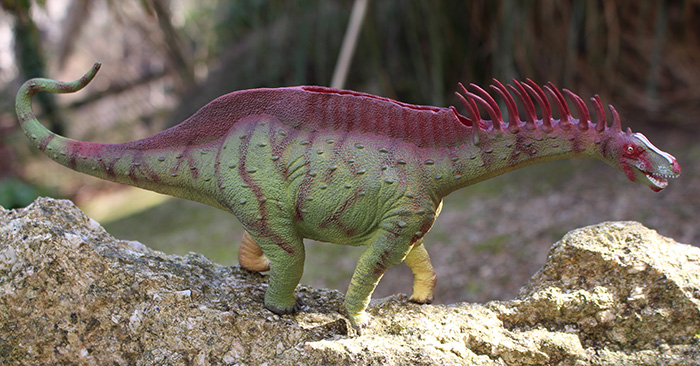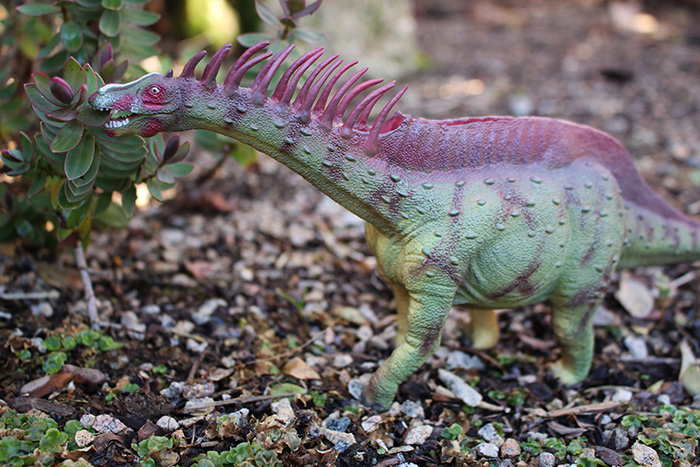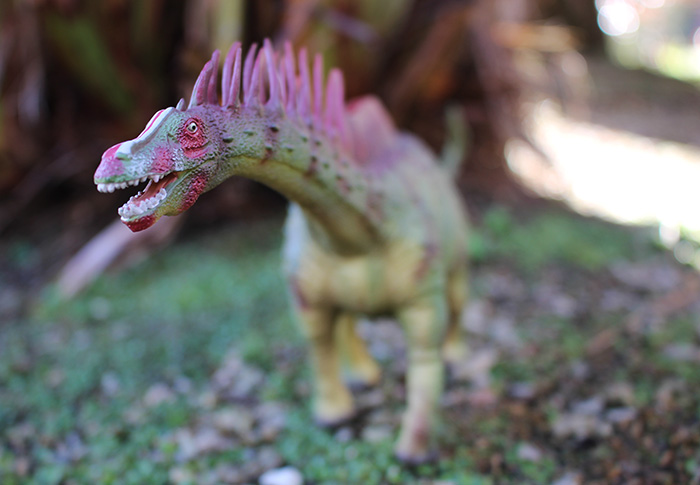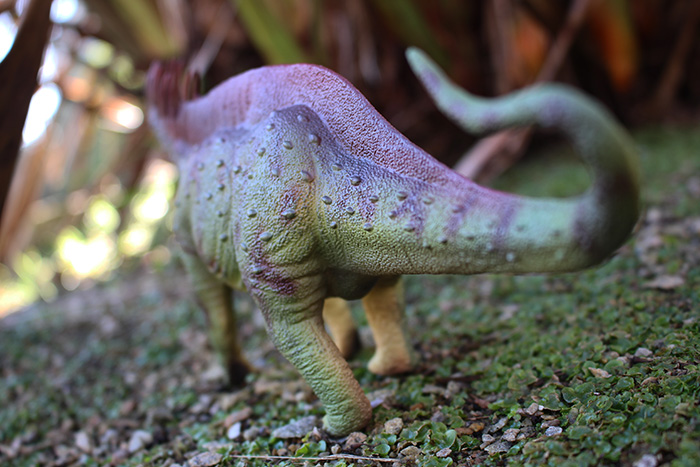Review and photographs by Tallin, edited by Plesiosauria.
One of the most recognisable of the sauropods, Amargasaurus cazaui has been well represented in toy form, with examples from most of the major brands. This is the second Amargasaurus that CollectA have released, this model dating back to 2012 and part of their 1:40 scale line – four years since their first attempt at recreating this beastie. Although this animal crops up often in toy lines (and even inspired a Pokémon design!) very few non dino enthusiasts seem to know it by name.

This creature is a genus of dicraeosaurid sauropod that lived during the early Cretaceous. Having evolved along a separate branch to the more well known diplodocids, these dinosaurs featured significantly shorter necks as well as being smaller overall than most other sauropods. Amargasaurus itself is estimated to grow only up to about 10 metres. One of its instantly apparent features are its long dorsal spines that run in two parallel rows down the neck and back, before merging back into the tail. Originally, palaeontologists hypothesised that these spines supported a sail. Now, however, it is widely accepted that this would have greatly impeded the movement of the animal’s neck, so most depictions now show the spines that run down the neck being naked. Some argue that these were also covered with horn and used to protect the vulnerable neck. The spines that continue down the back have been thought to either support a smaller double sail, or provide support for a fatty hump.

CollectA’s model shows the bizarre herbivore in a walking stance with the neck stretched out and mouth open. One can picture it straining for a particularly tasty piece of tree or bellowing a warning call to its fellows. The tail is held out straight until the tip, which is curled back over the top of the animal. The head is especially well detailed, with separate teeth and wrinkles around the eyes. Curiously, it seems they have picked up the recent idea of sauropods possessing fleshy nostrils at the front of their heads – which makes sense when you realise that it would be hard to sniff what’s in front of you if your nose was on your forehead, as shown in many sauropod depictions! CollectA have chosen to highlight this dinosaur’s radical new nose with a bright white and red stripe. The model is overall coloured with neutral olive-green which graduates to a sandier hue on the underside, a common colouration among dinosaur toys. However, the sails and spine are splashed with a pleasing, dull beetroot colour, which also forms stripes down the body. The eye is a bright golden-cream with a round black pupil. The bright white teeth would make any Mesozoic dentist proud.

The overall accuracy if this model seems very commendable. The proportions are in order, with the head perhaps being a touch on the large side. One criticism that I have noticed of this model is its rather rotund physique. It’s true that it does look rather deep compared to its legs, but I think that this is just the effect of the way the double sail becomes a thick ridge over the hips. The portly width of the animal seems reasonable if we consider that this may just be a particularly well fed and muscular individual. One tiny nit-pick for me is the size of the teeth – they look rather beefed up for just biting off plant material. The feet are very pleasingly accurate, with the crescent shape bottom of the foot more evident in this model than their rearing Diplodocus. They also have the correct number of toes. One other nit-pick perhaps are the large osteoderms that are dotted all over the sides of the animal, all the way down to almost the end of the tail. I’m no expert, but after some research I have seen evidence of osteoderms only in titanosaurid sauropods, a completely different family to the dicraeosaurids. These are, however, very nit-picky comments and the overall accuracy of the model is wonderful.

With these questionable osteoderms, a lovely fine scaled texture and copious skin folds and creases, this is a beautiful model and possible one of the best Amargasaurus models mass-produced. At 29cm long it is certainly one of the largest. It has a pleasing weight and quality feel, as well as a dynamic, interesting pose. It may not be particularly elegant, but this lends it a definite sense of mass and power. The neural spines are bendy, so would be of no danger in the hands of a rampaging child. Overall, I would thoroughly recommend this model to any collector, particularly if you have a liking for sauropods. It highlights the diversity amongst the sauropod family and definitely holds a lot of character and charm in its ever-so-slightly goofy expression.
Available from Amazon.com here.
Disclaimer: links to Ebay and Amazon on the DinoToyBlog are affiliate links, so we make a small commission if you use them. Thanks for supporting us!




Despite the obvious effort, this one doesn’t have the heavy, natural-looking grace of the Battat version. And are we sure the tail was likely to be this low-slung?
[…] up is a bantam Amargasaurus, based on the Deluxe version. Measuring slightly over 7 cm long, it’s light green with maroon stripes, yellow for the […]
[…] This was CollectA’s first attempt at the highly distinguishable sauropod, before releasing a deluxe figure a few years later. Of course, this strange early cretaceous dicraeosaurid was small by […]
Great review. Love the nibbling Amargasaurus pic!
I have 7′ high wall beneath a cathedral ceiling partitioning my kitchen from the L-shaped living-dining room, perhaps fourteen feet of 5″ deep sauropod display at the top in an L shape, featuring many a dramatic figure, yet everyone’s eyes invariably goes to this one. It is certainly an inspired model.